Ever wonder exactly how long you can keep that delicious batch of cooked shrimp in your fridge before it becomes unsafe? You're not alone. Millions of home cooks face this question weekly, and the answer isn't just about convenience—it's critical for preventing foodborne illness. Getting this wrong could lead to unpleasant digestive issues or worse. Let's explore exactly what you need to know to store cooked shrimp safely.
Understanding Refrigeration Timeframes for Cooked Shrimp
According to the USDA Food Safety and Inspection Service, cooked shrimp maintains safety for precisely 3-4 days in the refrigerator. This window assumes your refrigerator maintains a consistent temperature of 40°F (4°C) or lower—the critical threshold where bacterial growth significantly slows.
Why does this specific timeframe matter? Bacteria like Vibrio and Listeria can multiply rapidly in the "danger zone" between 40°F and 140°F. While cooking destroys most pathogens initially, improper storage allows surviving bacteria to reproduce to dangerous levels.
| Storage Method | Temperature | Maximum Safe Duration | Recommended Container |
|---|---|---|---|
| Refrigeration | 40°F (4°C) or below | 3-4 days | Airtight container |
| Freezing | 0°F (-18°C) or below | 2-3 months | Freezer bag with air removed |
| Room Temperature | Above 40°F (4°C) | 2 hours max (1 hour if above 90°F) | Not recommended |
Factors That Shorten Cooked Shrimp's Refrigeration Life
Not all cooked shrimp lasts the full 4 days. Several critical factors can reduce this timeframe significantly:
- Initial cooking temperature - Shrimp cooked to only 120°F instead of the recommended 145°F may contain more surviving bacteria
- Cooling method - Leaving shrimp at room temperature for more than 2 hours before refrigerating accelerates spoilage
- Refrigerator temperature fluctuations - Opening the door frequently raises internal temperature
- Storage container type - Non-airtight containers allow moisture and bacteria transfer
- Added ingredients - Shrimp in sauces or mixed dishes may spoil faster than plain cooked shrimp
Research from FoodSafety.gov shows that cooked seafood stored in non-airtight containers experiences 40% faster bacterial growth compared to properly sealed containers.
Step-by-Step: Maximizing Cooked Shrimp Freshness
Follow these professional chef techniques to extend your cooked shrimp's safe storage period:
- Immediate cooling - Spread shrimp in a single layer on a baking sheet immediately after cooking
- Rapid chill - Place the baking sheet over ice water (without submerging) for 5-7 minutes
- Proper container selection - Transfer to glass or BPA-free plastic containers with tight-fitting lids
- Strategic placement - Store in the coldest part of your refrigerator (usually the back, bottom shelf)
- Labeling system - Note the storage date on the container with a masking tape label
Professional kitchens follow this exact process to maintain food safety standards. As Antonio Rodriguez explains, "The difference between safe and risky leftovers often comes down to those critical first 30 minutes after cooking—how quickly you get food through the danger zone determines everything that follows."

Recognizing Spoiled Cooked Shrimp: The Warning Signs
Before consuming refrigerated cooked shrimp, perform these three critical checks:
1. The Smell Test
Fresh cooked shrimp should have a mild, ocean-like scent. Discard immediately if you detect:
- Strong ammonia odor
- Sour or acidic smell
- Any putrid or rotten scent
2. The Texture Check
Properly stored cooked shrimp maintains firmness. Warning signs include:
- Slippery or slimy surface
- Excessive moisture in the container
- Soft, mushy texture when pressed gently
3. The Visual Inspection
Look for these visual red flags:
- Grayish or yellow discoloration
- Mold spots (any color)
- Cloudy cooking liquid
When in doubt, throw it out. The USDA emphasizes that you cannot smell or see all dangerous bacteria—some pathogens like Listeria produce no noticeable odor even when present in dangerous quantities.
Freezing Cooked Shrimp: Your Long-Term Solution
Need to store cooked shrimp beyond 4 days? Freezing extends safety to 2-3 months. Follow these steps for best results:
- Cool shrimp completely using the rapid chill method described earlier
- Arrange in a single layer on parchment paper-lined baking sheet
- Flash freeze for 1-2 hours until solid
- Transfer to labeled freezer bags, removing as much air as possible
- Store at 0°F (-18°C) or lower
Thaw frozen cooked shrimp safely by placing in the refrigerator for 24 hours. Never thaw at room temperature, which creates perfect conditions for bacterial growth.
Food Safety Risks of Consuming Spoiled Shrimp
Eating shrimp past its safe storage window risks several foodborne illnesses:
- Vibrio infection - Causes watery diarrhea, abdominal cramps, nausea (onset: 12-72 hours)
- Listeriosis - Particularly dangerous for pregnant women and immunocompromised individuals
- Salmonella - Causes fever, diarrhea, stomach cramps (onset: 6 hours to 6 days)
According to CDC data, seafood causes approximately 18% of all foodborne illness outbreaks annually. Proper refrigeration dramatically reduces these risks.
Practical Storage Timeline for Cooked Shrimp
Understanding the progression of bacterial growth helps make informed decisions:
- 0-2 hours after cooking: Critical window for rapid cooling—must reach 40°F within this timeframe
- Day 1-2: Peak freshness and safety—optimal consumption period
- Day 3: Still safe but quality begins declining—perform all spoilage checks carefully
- Day 4: Final safe day—many food safety experts recommend consuming by this point
- Day 5+: High risk period—USDA advises discarding at this stage regardless of appearance
This timeline comes from extensive research by food safety laboratories tracking bacterial growth in cooked seafood under controlled conditions.











 浙公网安备
33010002000092号
浙公网安备
33010002000092号 浙B2-20120091-4
浙B2-20120091-4